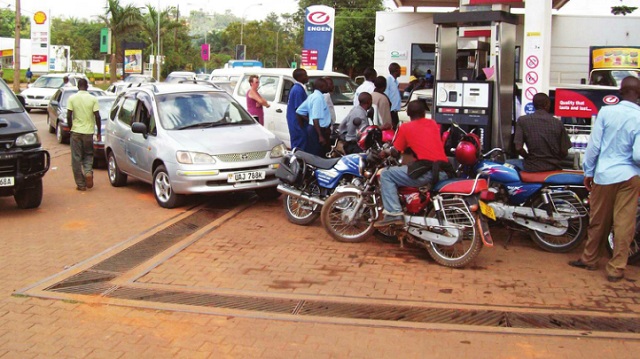
More storage facilities in offing as private players increase storage capacity to match the growing demand
Kampala, Uganda | JULIUS BUSINGE | With the current expansion of Uganda’s industry and manufacturing, transport, and services sectors in addition to a rapidly growing population,which are key consumers of petroleum products, one key question to ask those in charge is; Is Uganda finally moving towards a fuel-secure destination?
One of the answers to this question is the new glittering face of Jinja Storage Terminal (JST), a government facility at Walukuba village, Jinja Municipality, in Eastern Uganda.
It is a 30 million litre fuel reserve facility which was renovated recently and re-launched by top government officials on Nov. 03. It has five tanks.
The facility, which is supposed to store fuel to cushion the country from supply shocks, has for many years been poorly managed by government and contracted private companies.
Experts say the cost of filling these tanks and thereafter ensuring safety and security of the reserves requires commitment of large budgets and a wealth of experience in the operation of petroleum terminals. This has been lacking.
Sometime in 2007, Uganda recorded an over 100% jump in pump prices due to shortage of fuel caused by the bloody 2007 Kenyan post election violence that cut off importation of the product through Mombasa Port.
In response, in 2012, government hired a private company; Hared Petroleum Limited (HPL), to operate the facility by storing at least 12 million litres of fuel as a minimum.
However, HPL failed to live up to the terms and conditions of the contract, as it only managed to regularly store less than 50% of the required 12 million litres.
This meant that the intended stock build up was not being achieved and consequently, the country could risk having a fuel crisis in the event private players also failed to stock above their normal stock.
When the matter reached the floor of Parliament, government was forced to terminate HPL’s contract and, on June 14, 2017, replaced it with One Petroleum Uganda Limited (OPL) to operate the facility under close supervision by government’s company – Uganda National Oil Company (UNOC).
Figures obtained by The Independent in the course of doing this story shows that so far the facility is up and running well. Fuel reserve stock kept in the facility has increased from 0.36 million litres in June 2017 to 13.64 million litres in October for both petrol and diesel, higher than the contractual 12 million litres directed by the government to One Petroleum and UNOC.
When this reporter visited the facility in Jinja on Dec.06 at 8:50am, seven fuel trucks marked with ‘petroleum transit goods’ were packed outside the facility as one truck was seen exiting the premises.
A few metres away from the facility were privately owned fuel storage tanks branded by Gapco and Total, with two trucks packed around nearby. Total is one of the nine fuel distributing companies listed as clients of the JST. The others are Vivo energy, Oryx, Stabex, Mogas, Hass and others.
A man in his late 40s and resident of Walukuba village told The Independent that the facility is “now busy compared to some years back when a few trucks would be seen around coming and leaving the facility”.
“I don’t know who owns that place but what I see these days are many trucks that come here on a daily basis,” he said.
A truck driver onsite told The Independent on condition of anonymity that on average each truck driver did two routes – transporting fuel to different service stations in Kampala and other areas.
“We are not resting,” the driver said, adding that several trucks arrive at the facility from Kenya daily.
These revelations mean that JST is now operational and the country is making progress towards petroleum supply security.
Officials at UNOC told The Independent that One Petroleum is charged with storing fuel and selling to private players on condition that a minimum of 12 million litres are maintained to serve in times of shock or supply disruption.
John Friday, the assistant commissioner for petroleum supply at the Ministry of Energy and Mineral Development said that government was planning to set up more of such strategic facilities across the country to store more than 100 million litres of fuel in the long run.
“We have also just concluded a master plan for development of a major terminal near Kampala city. In the long term, such regional facilities are also to be developed in Western and Northern Uganda,” Friday said.
He said the financing and operation of petroleum terminals is a major undertaking, requiring large capital expenditure and experience in development and operation.
“The Ministry has been working on the development of joint ventures with the private sector to advance this policy action,” he said, adding, “It is in this spirit that the ministry handed over the JST to UNOC to ensure that it is managed in a commercial manner.”
The UNOC/One Petroleum joint venture took over the Jinja facility just before the recent general elections in Kenya, their immediate task being to refurbish and re-stock the JST.
“We are happy to note that this has worked quite well with the terminal now rehabilitated and fairly stocked even without funding from the treasury,” Friday said.
One Petroleum Limited is backed by 50 million litres terminal capacity at Mbaraki in Mombasa and more than 100 bulk transportation trucks.
 The Independent Uganda: You get the Truth we Pay the Price
The Independent Uganda: You get the Truth we Pay the Price


